While taking care of some long-neglected chores on my back patio recently, I had the opportunity to watch a Horsefly-like Carpenter Bee, Xylocopa tabaniformis (parkinsoniae?), drill into the wood frame of the covered porch. Grateful that she distracted me from a responsibility I didn’t much want, I watched her zoom to, from, and around her target building site. 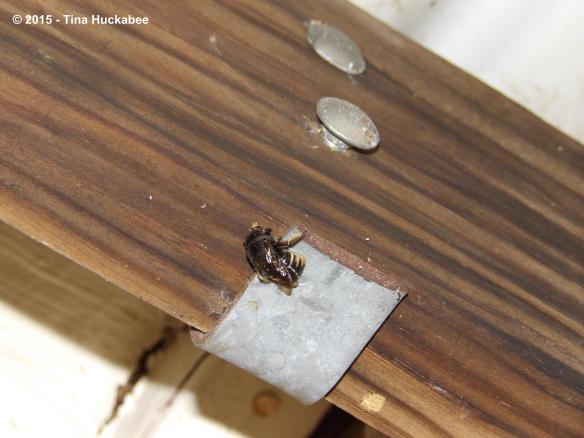
She examined other potential nesting spots along the woodwork, but returned again and again,
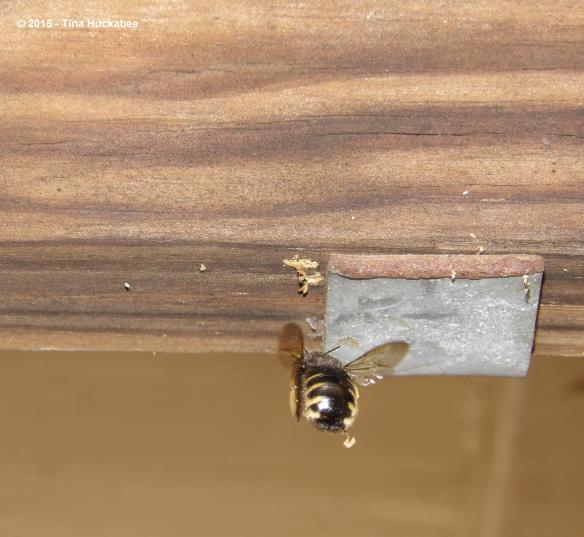 …to the spot that she intended, for a particular moment in time, to become a nest for her youngins’.
…to the spot that she intended, for a particular moment in time, to become a nest for her youngins’.
I love these bees, but they are hard to photograph. While solitary bees in their living habits, I find them quite social and gregarious. They buzz around me almost every time I enter my garden and I find them chasing each other around plants, in a comical Apidae version of hide-n-seek. Obviously that is territorial protective behavior, but fun to watch. While not shy about buzzing me, they have never been, in the least, aggressive.
I certainly can’t say the same thing for my beloved honeybees–and I have the welts to show for it.
I was able to get good photos of Ms. Horsefly-like Carpenter Bee because she was intent upon her woodworking and not zooming hither and thither, as is typical of this bee species.
This Carpenter bee species is especially cute: sporting pretty blue eyes and cool racing-strips along the sides of their abdomens, they’re common pollinators in my gardens.
Regardless, it took me a long time to correctly identify this particular species of bee.
I can easily get the racing-stripes in photo-form,
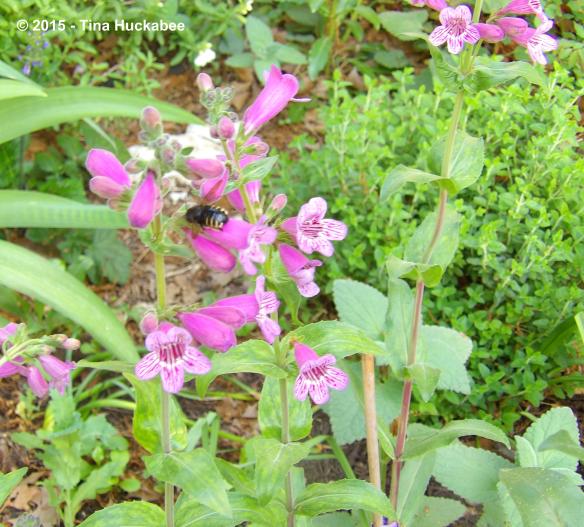 …but have yet to successfully photograph a bee head-on, to profile those baby-blues.
…but have yet to successfully photograph a bee head-on, to profile those baby-blues.
Most photos are blurred visions of bee action.
I watched this bee in the morning, then had to leave for the day. When I came home that evening,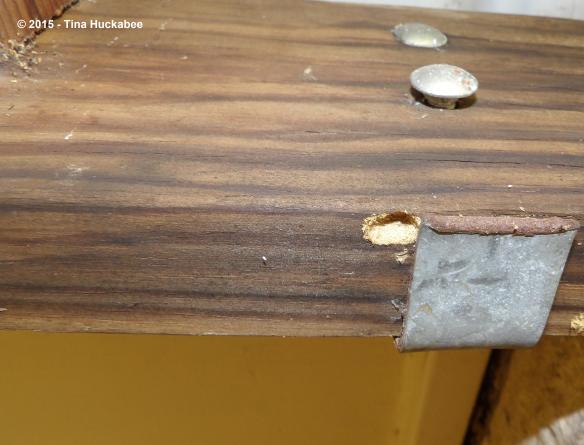
…I saw two holes, the larger is the one she worked on while I watched and a smaller one, to its right. It doesn’t look like she finished her carpentry with either. Or perhaps, she decided that the neighbor with the camera is just too nosy.
Maybe she found a more suitable home and a quieter neighborhood in this old wood.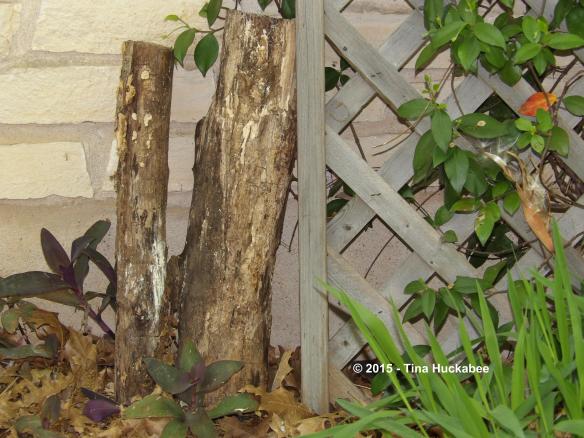
I spied her, or another, buzzing around, clearly interested in this piece of real estate. A nest hole made by native bees might look like this hole.
….is what I found in the back of that selected piece of wood. The wood shavings suggest that somebody is creating a nesting site. I carefully picked up the rotting log and looked at the back of it–there she is! Mamma Carpenter Bee!
Racing stripes visible in the depth of the hole, is she crooning to her eggs, singing sweet buzzy-bee lullabies ? More than likely, she’s packing pollen in the hole for her larvae to snack on once hatched. I’m leaving the nursery alone–Ms. Horsefly- like Carpenter Bee and her progeny don’t need me bugging them.
Maybe after she’s completed her motherhood responsibilities, I could hire her for some carpentry work? There are a couple of holes in the frame of my back patio cover….

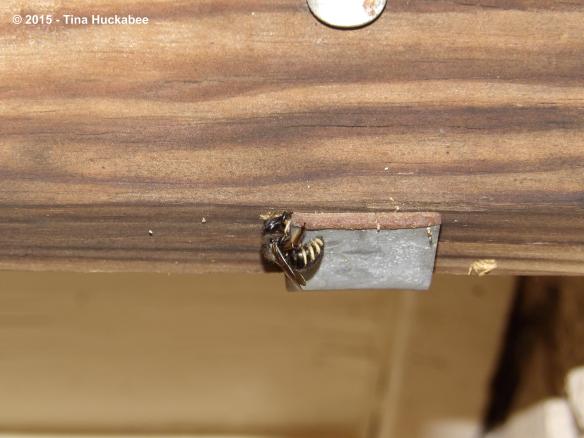
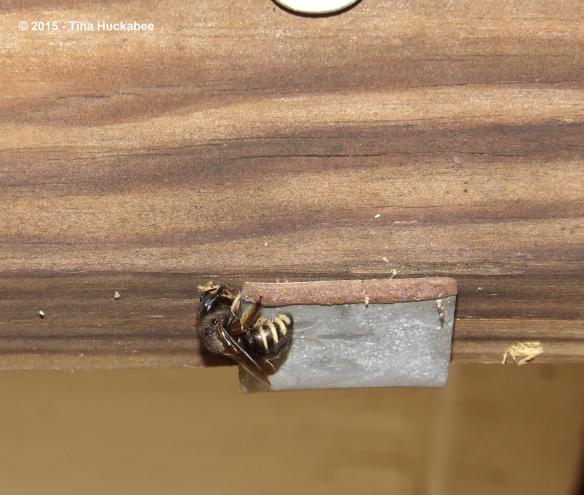
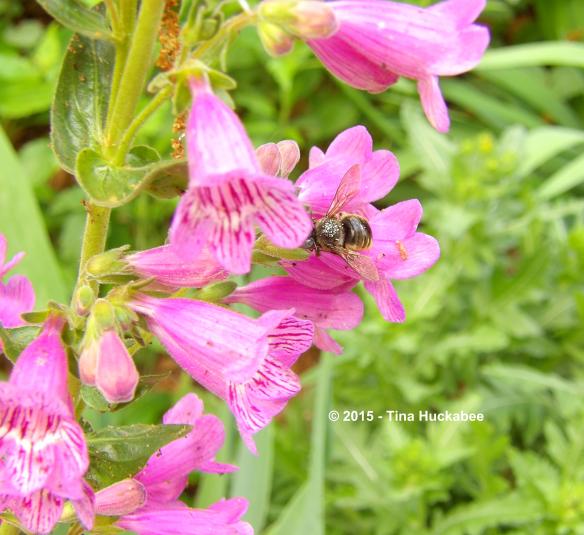
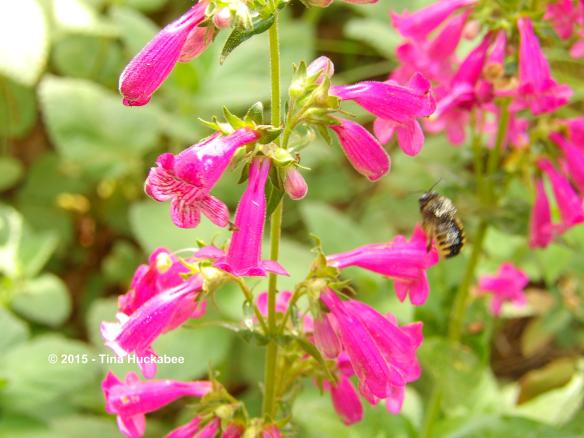
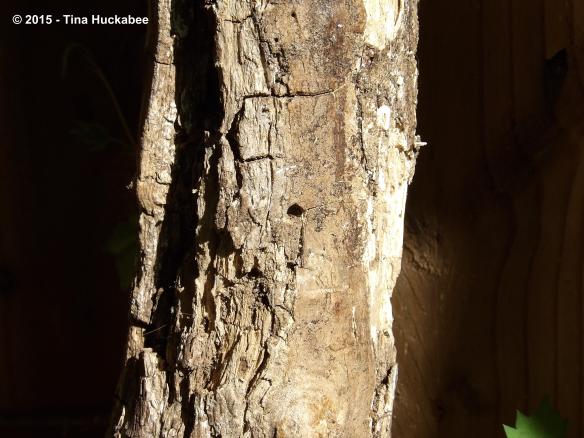

Now you’ve set me to wondering… If we human mamas had to chew a home for our babies and then stuff it with snacks – all using our mouths – how might that affect the over population situation? I say I’ll try anything once (and usually mean it) but I don’t know…
Once Ms. Bee finishes at your place please send her over to mine? I’ve got lots of holes/projects to be investigated and she can have all the oak pollen she wants. In fact maybe I’ll just box some up and send it to you right now.
LikeLike
Uh, gee. Thanks Deb for your kind offer of pollen, but….ACHOO!!! I’ll pass.
Did you happen to see “Nature” last night? It was about birds and their nest building. At one point, the host built a nest and it totally didn’t hold up (like real birds’ nest do, in weather and sometimes for years) and the interviewer then said–try building it with your mouth. So, yeah, we’re a little behind the curve. 🙂
LikeLike
We DVRed that – plan to watch it this weekend. I remember hoping there were bower birds involved – such artists.
LikeLiked by 1 person
Oooh, I don’t remember bower birds, but there were some birds who use adobe to build their nests. As it always is, Nature was fabulous to watch.
LikeLike
What a great post. Fascinating. Carpenter bees are great fun to watch but I’ve never seen one build a nest before. Great catch.
LikeLike
Yeah, dumb luck. 🙂 The bee in the hole was photographed a few days after the woodworking episode on the back patio. I don’t know if I have more native bees this spring, or if I’m just noticing them more. Either way, what a show!
LikeLike
We get a species of these carpenter bees also. You can actually hear them chewing once inside a hole, and see the sawdust falling out of the hole. Not the greatest bee to have when one has board and batten siding, which is why were are looking to install vinyl siding in the near future.
LikeLike
I’ve heard my bees too! And I’ve read that others hear them. Noisy little bees. Yeah, I guess you’d better avoid the wood siding.
LikeLike
Great captures of her on the wood! You were in the right places at the right time. The nest spot in the old wood log seems like a great selection for her. 🙂 I see these carpenter bees in my garden quite often. I enjoy their unique flight patterns.
LikeLike
I think those bees really favor rotted wood. I have a number of logs placed around my gardens and they all have holes in them–hopefully, full of bee larvae.
They are fun to watch fly–they sort of hover while glaring.
LikeLike
I love watching bees drill into wood…of course not on my gazebo so we left stumps and snags for them…
LikeLike
Yeah, you don’t want them messing with your gazebo. They are fun though, aren’t they?
LikeLike
Love learning about a new bee through your careful detective work!
LikeLike
She made my detective work easy!
LikeLiked by 1 person
Just shared this post with another blogger who is interested in native bees:http://honeychickhomestead.com/2015/04/17/horray-for-native-bees/
LikeLike
Great post!!!
LikeLike
Thanks, Rooster!
LikeLike